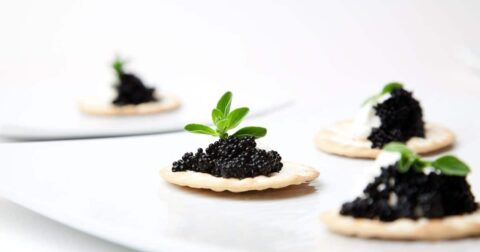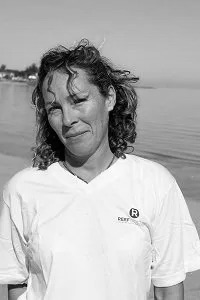Feature
How America’s Largest Meat Company Leverages Palantir’s Surveillance Tech
Food•10 min read
Reported
Touring a caviar farm gives a rare glimpse into the life of a captive sturgeon.


Words by Rachael Adams
Nestled between the Spanish Pyrenees, a farm sits next to a fast-running river from which clear water flows into open-air but barren, concrete-bottomed tanks. Visitors are given a tour of the facility, watching young fish as they’re caught in nets and lifted ashore for visitors to photograph. The fish, gills gasping for oxygen, produce abundant mucous that the guide explains is a sign of stress.
This is Nacarii Cavia, a farm that produces award-winning caviar. The salted, pressed and cured eggs of the sturgeon fish have long been the preserve of the rich, costing around $50 to $75 per ounce, with some varieties costing upwards of several hundred dollars for that same serving size.
Tours at Nacarii give visitors a glimpse into the lives of captive sturgeon. In the wild, these fish can live for decades, zig-zagging along the muddy sediments of rivers and estuaries searching for mussels, crabs and shrimps with the delicate barbels and electro sensors on their heads. But when wild stocks of sturgeon dried up in the 1990’s, caviar producers turned primarily to aquaculture operations like this one, where the daily experiences for these sturgeon couldn’t be more different.
Nacarii, like most caviar farms, has published a set of standards to ensure quality, environmental sustainability, food safety and traceability. But what the farm doesn’t address is what kind of life — and death – do these sturgeon experience?
According to my tour guide at Nacarii, fish are sexed here when they reach four years of age — kept out of the water for up to 10 minutes to have their gonads examined with an ultrasound. Procedures take place with the fish lying on their backs in a type of “fish stretcher.” Males are filleted straight away and females are left to grow to adulthood.
While fish in captivity reach maturity much faster than those in the wild, an intensively- reared female doesn’t produce her first eggs until around 7 years old, by which point she may weigh more than 60 pounds and measure up to 1.5m in length. She has been fed an artificial diet of fish oil, fish meal, prawns and soy — her diet is part of why caviar is so expensive.
A few years later, the females are again scanned with an ultrasound to check for eggs. If she is carrying roe, she then undergoes a biopsy – or has a long thick needle inserted into her abdomen to extract an egg sample. If, after a few attempts, still no eggs are found, it is because the fish is either infertile or the gonads weren’t developed enough to reveal that it was, in fact, a male. If the eggs meet the quality requirements, she will then be electrocuted to death in a bath. Other farmers prefer dispatching their stock with a swift bash to the head.
According to a 2014 study, captive fish were found to have reduced brain activity as compared to wild ones. It’s even possible that sturgeon living in barren containers could lose their natural foraging and social learning behaviours over time. And there are other risks too — Victoria Braithwaite, who was an expert on animal behavior with Pennsylvania State University, explained in her book Do Fish Feel Pain? that fish can develop depression in monotonous surroundings.
To alleviate boredom and encourage the fish to move at Nacarii, staff sometimes throw pellet food to the sturgeon. The fish recognize their human handlers and follow along the walls of their tanks at feeding time. This is their sole distraction. When it’s too icy for staff to walk between the tanks, fish are fed from automatic feeders.
To improve living conditions for captive animals, many zoos and even some farms implement environmental enrichment strategies. Facilities can add structures to provide the opportunity for caged animals to play, forage, hide, exercise and interact with each other. They might also alter natural light and water movement to mimic real-life animal habitats.
Now, in 2022, thanks to behavioural studies on fish sentience from a growing number of researchers, seafood certifiers are beginning to develop welfare standards for aquaculture.
These welfare strategies are species-specific, sometimes even life-stage specific. According to researchers, sturgeon would benefit from softer bottom sediments that contain rocks, plants, sand and mud. Together with interesting food supplies and hideouts, these could reverse constricted movements and reduce fin and mouth lesions — two problems I observed at Nacarii.
Over the last 25 years, zoologist Lynne Sneddon has provided ample evidence that fish do, in fact, feel pain. They have pain receptors and can even produce natural painkillers to relieve pain. But as Jonathan Balcombe explains in his book What a Fish Knows, humans find it harder to read fish expressions or hear their cries — making it easier to ignore their suffering.
Recently, however, there has been progress. The U.K. has just passed the “Animal Welfare (Sentience) Act 2022” to include fish, showing governments can recognize fish sentience.
When contacted for comment, Nacarii responded that they are exploring ways to make their holding tanks a more natural environment for sturgeon in the future. They are phasing out the part of their tour where the guide removes the fish from the water too, perhaps eliminating at least one cause of stress in the future.